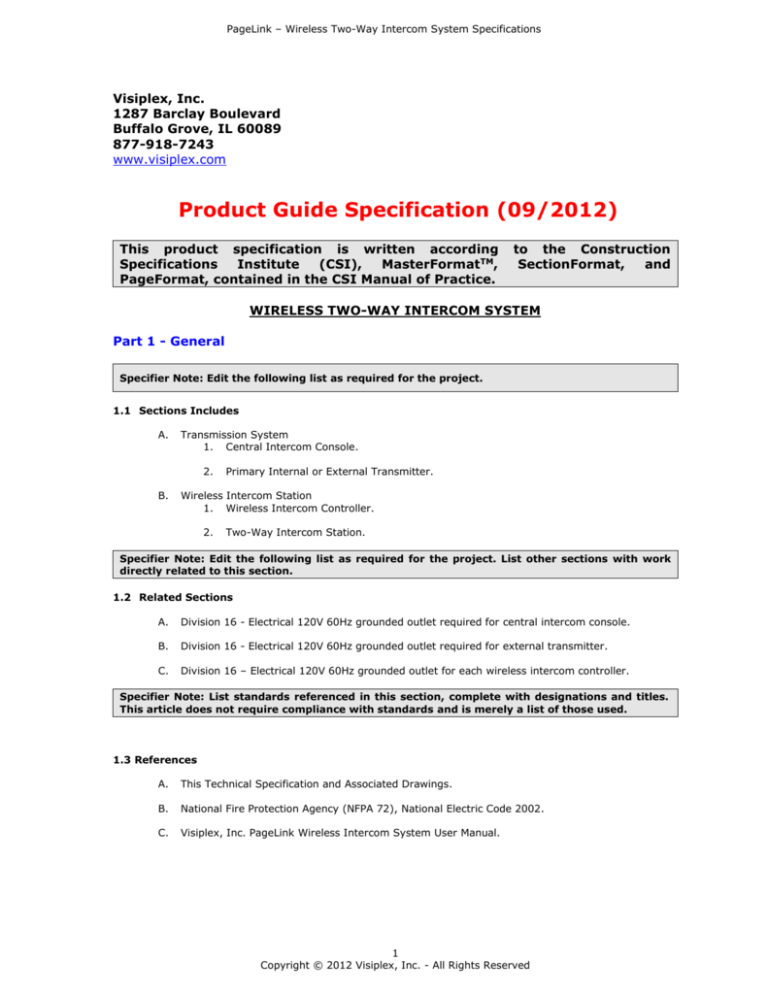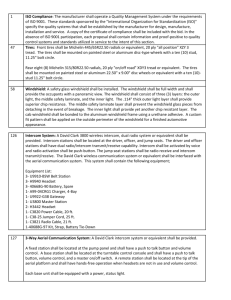
PageLink – Wireless Two-Way Intercom System Specifications
Visiplex, Inc.
1287 Barclay Boulevard
Buffalo Grove, IL 60089
877-918-7243
www.visiplex.com
Product Guide Specification (09/2012)
This product specification is written according
Specifications
Institute
(CSI),
MasterFormatTM,
PageFormat, contained in the CSI Manual of Practice.
to the Construction
SectionFormat,
and
WIRELESS TWO-WAY INTERCOM SYSTEM
Part 1 - General
Specifier Note: Edit the following list as required for the project.
1.1 Sections Includes
A.
Transmission System
1. Central Intercom Console.
2.
B.
Primary Internal or External Transmitter.
Wireless Intercom Station
1. Wireless Intercom Controller.
2.
Two-Way Intercom Station.
Specifier Note: Edit the following list as required for the project. List other sections with work
directly related to this section.
1.2 Related Sections
A.
Division 16 - Electrical 120V 60Hz grounded outlet required for central intercom console.
B.
Division 16 - Electrical 120V 60Hz grounded outlet required for external transmitter.
C.
Division 16 – Electrical 120V 60Hz grounded outlet for each wireless intercom controller.
Specifier Note: List standards referenced in this section, complete with designations and titles.
This article does not require compliance with standards and is merely a list of those used.
1.3 References
A.
This Technical Specification and Associated Drawings.
B.
National Fire Protection Agency (NFPA 72), National Electric Code 2002.
C.
Visiplex, Inc. PageLink Wireless Intercom System User Manual.
1
Copyright © 2012 Visiplex, Inc. - All Rights Reserved
PageLink – Wireless Two-Way Intercom System Specifications
1.4 System Description
A.
Wireless intercom system shall be able to provide two-way voice communications between a
central location and remotely located intercom stations.
B.
The central intercom console shall be able to wirelessly initiate a call to any of the remote
intercom stations and begin two-way voice communication.
C.
Each of the remote intercom stations shall be able to initiate a call to the central intercom console
to begin two-way voice communication.
D.
The two-way voice communication between the central intercom console and the remote
intercom stations can be carried in ‘Hands Free’ or ‘Push to Talk’ modes.
E.
The central intercom console can initiate a ‘Page All’ call and activate all remote intercom stations
for Public Address voice announcements.
F.
The system shall incorporate a “fail-proof” power backup option so that a temporary power
interruption shall not cause system failure to provide voice communication between the central
main controller and the remote intercom stations.
G.
The system shall provide a PC interface to enable system remote programming and maintenance.
H.
The system shall be capable of providing a built-in programmable bell/tone weekly schedule to
activate bells and other tone signaling through the remote intercom stations.
I.
The system shall be capable of providing a voice gateway to activate wireless Public Address
amplifiers and speakers. Voice messages can be initiated in real time over the phone, using a
hand held microphone or automatically according to a preprogrammed event schedule.
J.
The system shall be capable of providing an internal phone interface to initiate voice and data
messaging and control event schedule selection.
1.6 Regulatory Requirements
A.
Equipment and components furnished shall be of manufacturer’s latest model.
B.
Encoder, transmitter and receivers shall comply with Part 90 of FCC rules, as follows:
1. This device may not cause harmful interference.
2. This device must accept interference received, including interference that may cause
undesired operation.
3. Transmitter frequency shall be governed by FCC Part 90.35.
4. Transmitter output power shall be governed by FCC Parts 90 and 74.
C.
System shall be installed in compliance with local and state authorities having jurisdiction.
1.7 Submittals
Specifier Note: In accordance with FCC regulations, an application for license must be filed prior
to use of the equipment. Normally, the manufacturer will complete the filing and obtain the
license on the behalf of the Owner.
Otherwise, the Owner will be required to file the application with the FCC prior to use.
Furnishing the license, or a copy of the application, will confirm that FCC approval has been
obtained.
A.
Product Data: Submit complete catalog data for each component, describing physical
characteristics and method of installation. Submit brochure showing available colors and finishes
of intercom stations, wireless controllers and speakers.
B.
Operating License: Submit evidence of application for operating license prior to installing
equipment. Furnish the license, or if the license has not been received, a copy of the application
for the license, to the Owner prior to operating the equipment. When license is received, deliver
original license to Owner.
2
Copyright © 2012 Visiplex, Inc. - All Rights Reserved
PageLink – Wireless Two-Way Intercom System Specifications
C.
Samples: Submit one intercom station for approval. Approved sample shall be tagged and shall
be installed at the location directed.
D.
Manufacturer's Instructions: Submit complete installation, set-up and maintenance instructions.
1.7 Substitutions
A.
Proposed substitutions shall be manufactured of equivalent materials that meet or exceed
specified requirements of this section.
B.
Proposed substitutions shall be identified not less than 10 days prior to bid date.
C.
Systems requiring wiring and/or conduit between the central intercom console and remote
controllers/intercom stations will not be acceptable.
1.8 Quality Assurance
A.
Permits: Obtain operating license for the transmitter from the FCC (service may be provided by
Visiplex).
B. Qualifications:
1.
Manufacturer: Company specializing in manufacturing commercial wireless systems with
a documented experience at minimum of 10 years.
2.
Installer: Company with documented experience in installation of commercial wireless
systems.
1.9 Delivery Storage and Handling
A.
Deliver all components to the site in the manufacturer's original packaging. Packaging shall
contain manufacturer's name and address, product identification number, and other related
information.
B.
Store equipment in finished building, unopened containers until ready for installation.
1.10 Project Site Conditions
A.
Intercom stations, wireless controllers and speakers shall not be installed until painting and other
finish work in each room is completed.
B.
Coordinate installation of the external antenna (if used) for access to the roof or exterior sidewall so that the bracket and related fasteners are watertight.
3
Copyright © 2012 Visiplex, Inc. - All Rights Reserved
PageLink – Wireless Two-Way Intercom System Specifications
Part 2 – Products
Specifier Note: Select from the following product list all products and options that fits your
system design. Consult Visiplex for additional information regarding product features and
options.
2.1 Manufacturer
A.
The Wireless Two-Way Intercom System components shall be manufactured by:
Visiplex, Inc.
Buffalo Grove, IL 60089
Tel: 877-918-7243
Website: www.visiplex.com
2.2 System Operation and Startup Sequence
The system central intercom console is a powerful multitasking device equipped with the power to
wirelessly initiate live or pre-recorded voice messaging to wireless intercom stations and Public
Address speakers. Calls can be generated using the controller’s hand-held microphone and keypad.
A.
Central Intercom Console Operation:
If the system is equipped with an external high-power transmitter, apply power to the
transmitter and turn it on. Next, apply power to the central intercom console - it shall display
the software version and then the main menu screen. At this point the central intercom
console is ready to initiate intercom and PA calls using the hand-held microphone and
keypad. Programming the encoder built-in database can be performed using the available PC
software.
B. Wireless Intercom/PA Controller Operation:
Connect the DC adaptor (supplied with each wireless controller) to AC power source.
Connect the cable between the intercom station and the wireless intercom controller.
If an external antenna is needed, connect the antenna to the wireless controller.
If an optional PA speaker is selected, connect the speaker connector to the appropriate
speaker output on the wireless controller.
Connect the power connector into the power input on the wireless intercom controller.
After a few seconds of initial setup, the wireless controller LED will start flashing to indicate
that all the internal circuitry is fully functioning and is ready to receive or initiate calls.
To initiate or answer a call, push the button on the intercom station.
2.3 Equipment
Specifier Note: Select the encoder with features as needed. Select suitable transmitter to provide
full coverage facility wide. In general, use an internal transmitter for single building and a more
powerful external transmitter for larger facilities.
A.
General:
A basic wireless intercom system shall include a central intercom console, a built-in or external
transmitter, wireless intercom controllers and intercom stations. An expanded system may also
include wireless PA speakers and/or a high power transmitter option for extended voice
communication range.
B.
Central Intercom Console:
Visiplex model VS4500, VS4800 or VS4810 that shall incorporate a display, keypad and provide
the following features:
1.
Include power supply, hand-held microphone and a built-in speaker for voice
communication with wireless intercom stations and PA speakers.
2.
Database programming and administration using its keypad and LCD display.
4
Copyright © 2012 Visiplex, Inc. - All Rights Reserved
PageLink – Wireless Two-Way Intercom System Specifications
C.
3.
Password protected Administrator Menu to set the date, local time zone, wireless
controllers and other system parameters as needed.
4.
Database programming and administration using its keypad and LCD display.
5.
PC RS-232 interface for programming and administration.
6.
High-precision internal clock that can synchronize from a GPS or PC.
7.
Capable of providing a telephone interface for remote voice access and system control.
8.
Capable of providing a programmable weekly or calendar event schedule.
Primary Transmitter:
Visiplex model VTX-x or VS101-xxx series transmitter with up to 300 watts. The transmitter
parameters shall be:
D.
1.
Frequency Range: 148-174 MHz or 401–470 MHz.
2.
Transmitter output power: Internal 2-6 watt (built into the encoder), External 25-40
watt in black metal case (14” by 3.5” by 11.5”) or External 100-300 watt in black metal
case (24” by 19” by 16.5”).
3.
Transmission Range: Up to 15 miles radius (depending on transmitter power and
antenna).
4.
Radio technology: Narrowband FM, 12.5 KHz bandwidth.
5.
Transmission format: POCSAG, digital and analog two-way communication.
6.
Digital Data rate: 1200 BPS.
7.
Operating range: 0-70 degrees Celsius.
Antenna:
Visiplex model VS638 (indoor), or model VS654 (outdoor) or model VS655 (outdoor). Antenna
polarization shall be vertical.
E.
Surge Protector/Battery Backup:
Visiplex model VS56450.
Input: 120-volt AC 60 Hz +/- 1 Hz.
Output: 120-volt AC, 750VA, 450-watts
Surge Energy Rating: 365 joules
F.
Wireless Intercom Controller/Station:
Visiplex model VNS2200, Indoor/Outdoor Wireless Controller with overall dimensions: 7.6” long
by 5.1” wide by 3” deep.
Visiplex model VNS2261 two-way intercom station with overall dimensions: 4.75” long by 3.45”
wide by 1.15” deep.
Specifier Note: For PA speaker options and models, please select from Visiplex brochure or
website.
1.
Wireless intercom controller shall be able to provide two-way voice communication with
the VS4500 central intercom console.
2.
Power source: 100-240 VAC, 50-60 Hz.
3.
Visiplex model VNS2263 High-power Transmitter option for long range two-way intercom
communications.
5
Copyright © 2012 Visiplex, Inc. - All Rights Reserved
PageLink – Wireless Two-Way Intercom System Specifications
6
Copyright © 2012 Visiplex, Inc. - All Rights Reserved
PageLink – Wireless Two-Way Intercom System Specifications
Part 3 – Installation
3.1 Site examination:
A.
Verify that construction is complete at installation locations and that rooms are clean and dry.
B.
Verify that 120-volt electrical outlet is located within 6 feet of location of transmitter and the
outlet is operational and properly grounded.
C.
Verify that all 120-volt electrical outlets for the wireless intercom controllers are located at the
exact installation point and that the outlet is operational and properly grounded.
3.2 System Installation: Refer to the manufacturer installation manuals as supplied with the system and
install each one of the system components.
3.3 Inspection: Prior to final acceptance, inspect each system component for proper function and replace
parts that are found to be defective.
3.4 Cleaning: Prior to final acceptance, clean exposed surfaces of all system components, using cleaning
methods recommended by the manufacturer.
3.5 Delivery: Provide training to Owner's representative on system setting and operation as demonstrated in
the manufacturer system user manual.
7
Copyright © 2012 Visiplex, Inc. - All Rights Reserved







